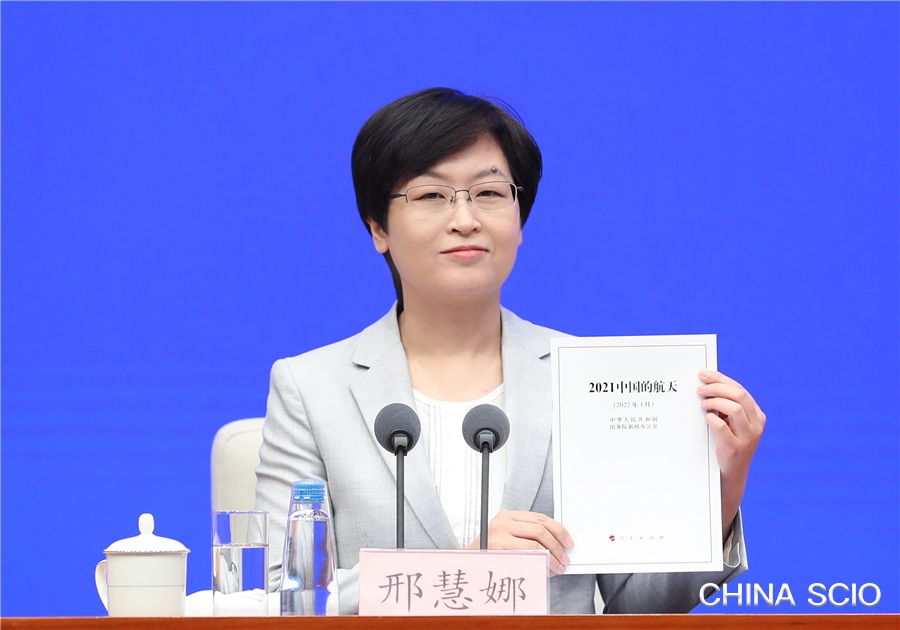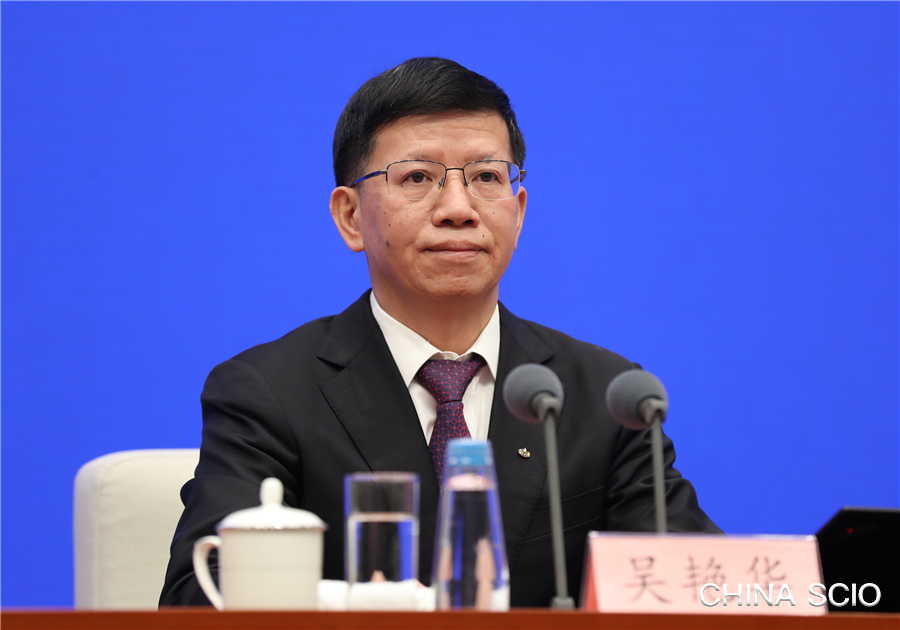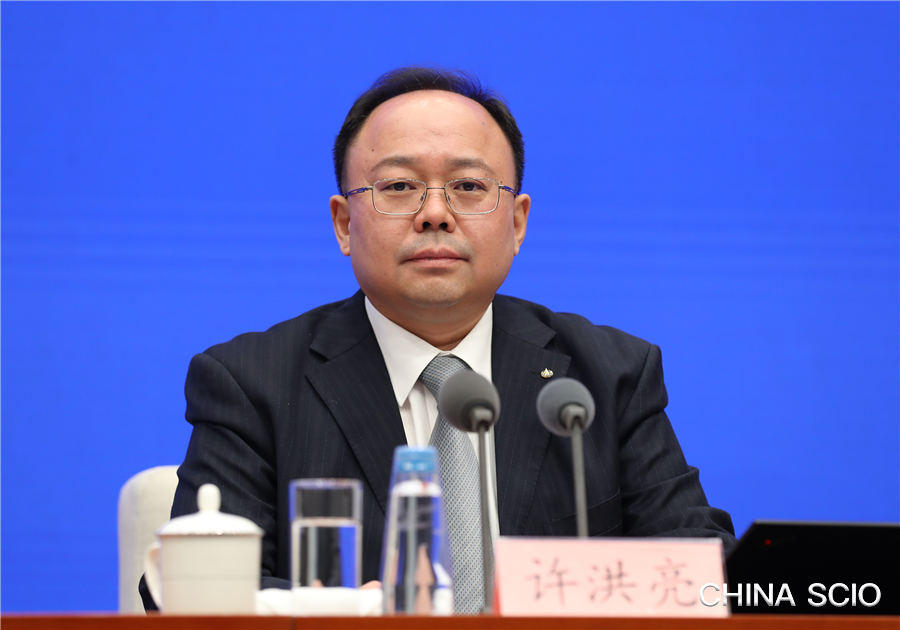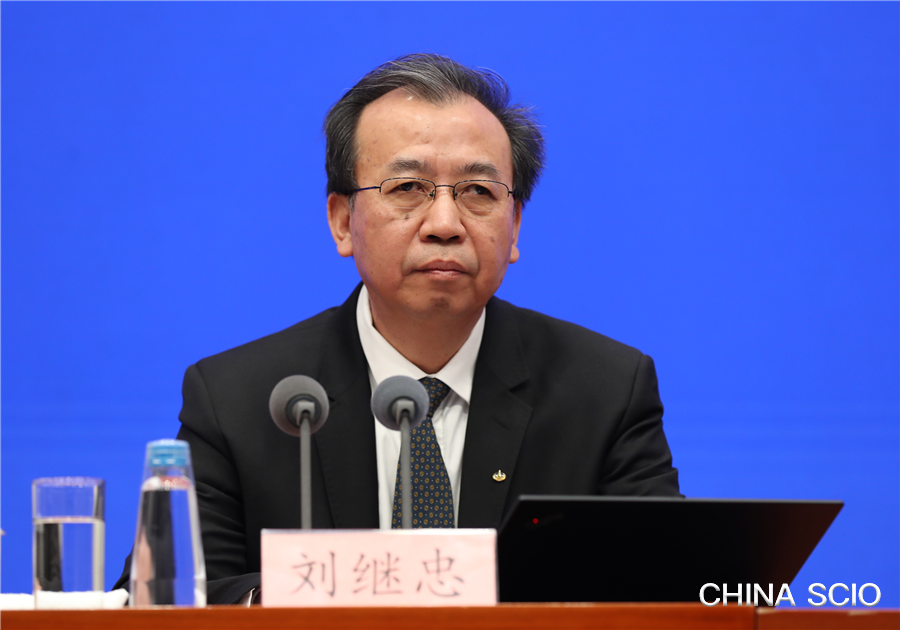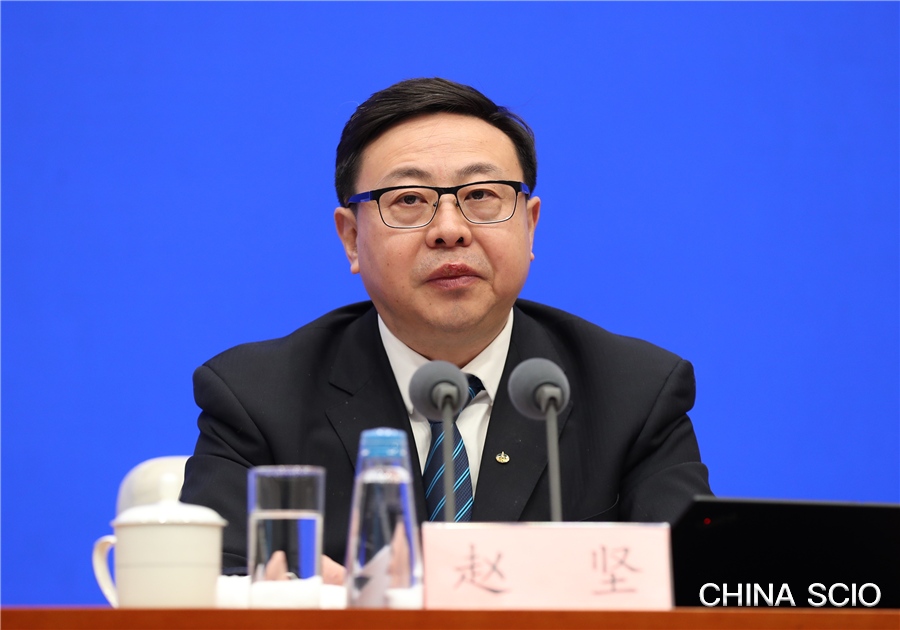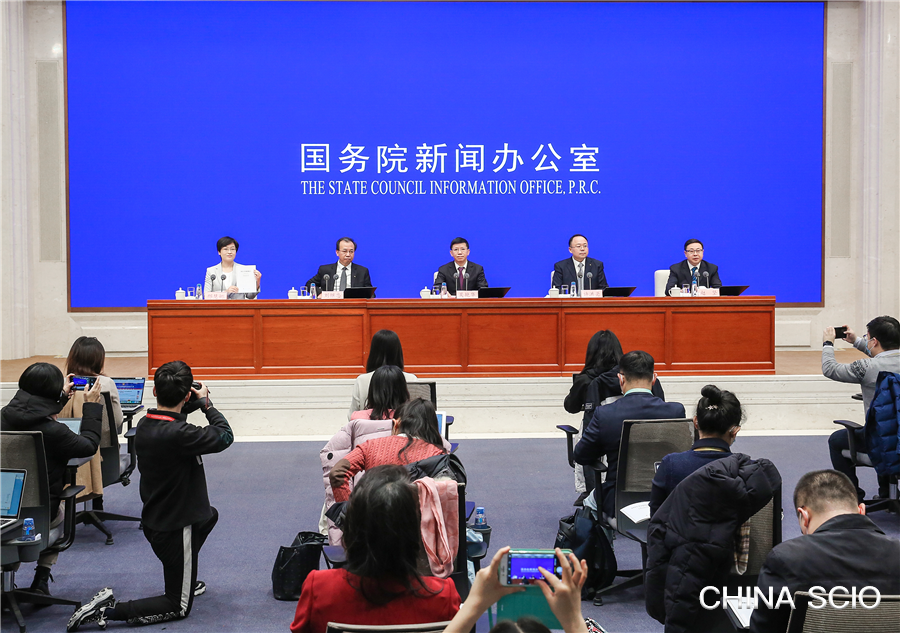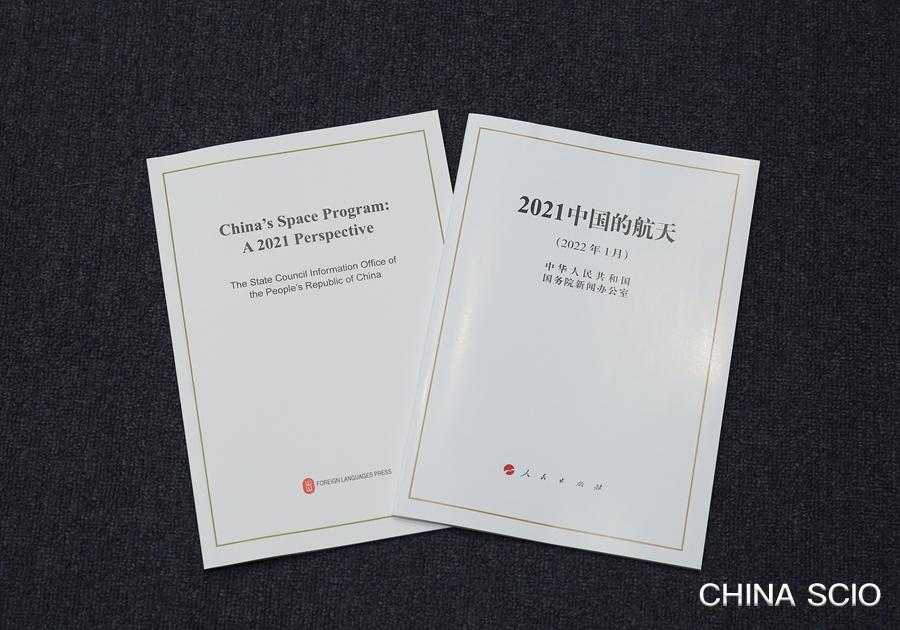.
Read in Chinese
Speakers:
Wu Yanhua, vice administrator of the China National Space Administration (CNSA)
Xu Hongliang, spokesperson of the CNSA
Liu Jizhong, director of the Lunar Exploration and Space Program Center of the CNSA
Zhao Jian, director of the Earth Observation System and Data Center of the CNSA
Chairperson:
Xing Huina, deputy director general of the Press Bureau of the State Council Information Office (SCIO) and SCIO spokesperson
Date:
Jan. 28, 2022
Xing Huina:
Ladies and gentlemen, friends from the media, good morning! Welcome to this press conference held by the State Council Information Office (SCIO).
Today, the SCIO is holding a press conference to issue, introduce and interpret the main contents of a new white paper titled "China's Space Program: A 2021 Perspective."
Thoroughly guided by Xi Jinping Thought on Socialism with Chinese Characteristics for a New Era, the white paper introduces China's practices and achievements in realizing innovative and leapfrog space development, modernizing space governance, and actively carrying out international space exchanges and cooperation. Furthermore, the paper explains China's policies and proposals in conducting international space communication and collaboration and facilitating building a global community of shared future in outer space. Finally, the paper also looks to the vision where China will embark on a new journey towards a space power and foster a new paradigm of international space cooperation over the next five years.
At about 13,000 Chinese characters, the white paper consists of three parts: the preamble, main body, and conclusion. The main body has six parts: A New Journey Towards a Strong Space Presence, Development of Space Technology and Systems, Developing and Expanding Space Application Industry, Research on Space Science, Modernizing Space Governance, and International Cooperation. The white paper is published in eight languages —Chinese, English, French, Russian, German, Spanish, Arabic, and Japanese — by the People's Publishing House and the Foreign Languages Press. It is available at Xinhua Bookstore outlets across the country.
In order to help you gain a more accurate and deep understanding of the white paper, we have invited Mr. Wu Yanhua, vice administrator of the China National Space Administration (CNSA); Mr. Xu Hongliang, spokesperson of the CNSA; Mr. Liu Jizhong, director of the Lunar Exploration and Space Program Center of the CNSA; and Mr. Zhao Jian, director of the Earth Observation System and Data Center of the CNSA, to attend today's press conference. They will introduce relevant information and answer your questions.
Now, I will give the floor to Mr. Wu Yanhua.
_ueditor_page_break_tag_
Wu Yanhua:
Ladies and gentlemen, good morning. I am glad to meet you and grateful for your care and support for China's space industry. Today, we are here to release China's fifth white paper on space activities — "China's Space Program: A 2021 Perspective" — to enhance your understanding of China's space development and envision the bright prospects for cooperation. China's space industry has forged ahead, secured new achievements, and made great strides in the past five years: the Chang'e lunar probes exploring the moon; the BeiDou Navigation Satellite System (BDS) starting operation; the Zhurong rover probing Mars; the Xihe satellite exploring the sun; the Tianhe space station core module traveling among the stars; and the Dark Matter Particle Explorer (also known as Wukong or Monkey King) and the Huiyan (Insight) Hard X-ray Modulation Telescope unraveling the mysteries of the universe.
The last five years have seen innovation and development for China's space industry. With the accelerated improvement of launch vehicles, the new generation of non-toxic and pollution-free launch vehicles, such as Long March-5, are now in service. The commercial carrier rockets have continued to emerge, forming a diversified launching capability covering land and sea. Over the past five years, a total of 207 launch missions have been completed, with the success rate of the Long March series carrier rockets being 96.7%. Major space programs have born rich fruit. The construction of China's space station is fully underway. Six astronauts have been stationed in two missions, starting an era of long-term presence of people in the space station. The Chang'e-4 lunar probe has performed humanity's first-ever soft landing on the moon's far side and conducting roving explorations; the Chang'e-5 lunar probe has retrieved 1,731 g of samples. The Tianwen-1 mission has left China's first mark on Mars for the first time, helping the country achieve a leap from cislunar to interplanetary exploration. The infrastructure of China's space station has been consistently improved. The BDS has been completed and put into operation. Meanwhile, the high-resolution earth observation system has built systematic capabilities.
The last five years have seen China's space industry contributing to society. More than 500 satellites of various types are operating in orbit, extensively serving socio-economic development and playing an essential role in building a peaceful, beautiful, and digital China. Communications satellites have provided more than 140 million families in rural and remote areas with remote education, telemedicine, and rural e-commerce services. Therefore, they have contributed to poverty alleviation and rural vitalization. In addition, more than 100 million remote sensing satellite images have been distributed, effectively fulfilling the demands of weather forecasting, territorial planning, ecological protection, the marine economy, and disaster emergency management. The BeiDou system has been widely used for traveling, intelligent logistics, and precision agriculture, especially providing precise positioning and navigation services in COVID-19 prevention and control. The space technology achievements have promoted the development of emerging industries, such as new energy and materials, and facilitated the emergence of new business forms such as smart cities and unmanned driving. The development of commercial space enterprises is thriving.
Over the past five years, China's space industry has made continuous exploration and breakthroughs. It has focused on scientific topics such as the origin and evolution of the universe and the relations between the solar system and humanity. It has been supported by space science satellites and lunar exploration, Mars exploration, and manned space missions. As a result, China's space industry has carried out exploration and experimental research on space science and has made a number of innovative achievements that all humanity can share.
For example, the Huiyan Telescope successfully observed the black hole explosion process. The Wukong Explorer acquired the refined structure of the energy spectrum of cosmic rays. The satellite Zhangheng-1 built models of the global geomagnetic field, and the TANSAT satellite developed a high-precision map of the worldwide distribution of carbon dioxide. The lunar exploration missions revealed the subsurface structure of the moon's far side, confirming that there were still magmatic activities on the moon 2 billion years ago. Finally, Tianqin-1, Taiji-1, and Xihe satellites have provided new research methods regarding space gravitational waves and solar physics.
The last five years have seen enhanced cooperation and sharing in China's space industry. The Chinese space community has cooperated with international partners to help realize the United Nations 2030 Agenda for Sustainable Development goals by applying sustainable aerospace technologies. It also signed about 50 agreements or memorandums of understanding during the last five years. For example, China initiated the International Lunar Research Station project jointly with Russia and conducted extensive cooperation in manned space exploration, lunar exploration, and Mars exploration missions. In addition, it has agreed to cooperate on the BRICS Remote-Sensing Satellite Constellation and successfully launched the China-France Oceanography Satellite and the China-Italy Electromagnetic Monitoring Experiment Satellite. Furthermore, it has promoted the BeiDou standards to be included in the standard systems of several international organizations in the fields such as civil aviation and maritime affairs. Data from Gaofen-1 and Gaofen-6 satellites have been distributed freely worldwide via a cloud platform, with about 550,000 users from 158 countries and regions accessing the data. In addition, five of China's satellites and three satellite constellations have joined the mechanism of the International Charter on Space and Major Disasters, and meteorological satellite data have been used in 121 countries and regions. China has supported the space capacity building of developing countries and shared the achievements of China's space development through various means, including infrastructure construction, talent training, and data application.
In the following five years, China's space industry will continue to follow the guidance of Xi Jinping Thought on Socialism with Chinese Characteristics for a New Era and adhere to the principles of innovation-driven, coordinated, efficient, and peaceful progress based on cooperation and sharing. Focusing on building China's strength in aerospace and developing a high-quality space industry will promote the comprehensive development of space science, space technologies, and space applications to contribute to building a great modern socialist country and to humanity's cause of peace and development.
First, we will promote the implementation of significant projects through innovation. We will build China's space station and the High-Resolution Earth Observation System, implement new major projects, including the fourth phase of the Lunar Exploration Program and planetary exploration, and promote the research and development of heavy-lift launch vehicles. We will establish near-earth asteroid impact risk response systems, develop essential programs such as the boundary exploration of the solar system, and further expand the launch vehicle family. Furthermore, we will continue to upgrade national space infrastructure and improve the ability of the space environment governance system.
Second, we will develop and expand the space application industry. We will promote the deep integration of space applications and the digital economy, enrich application scenarios, innovate business models, and deepen the comprehensive application of communications, navigation, and remote-sensing technologies. We will accelerate the transfer and transformation of space technology achievements to serve the economy and society and develop new business models of the space economy such as space travel, space biomedicine, and space breeding.
Third, we will make overall plans for research on space science. Critical areas such as space astronomy, space physics, lunar and planetary science, and space earth sciences will be systematically promoted. Space science satellites such as the satellite for space gravitational wave detection, the Einstein Probe, and an advanced space-based solar observatory will be developed. We will also use platforms including China's space station and lunar and deep space probes to continuously carry out frontier science exploration and basic research to generate more original scientific findings.
Fourth, we will create a sound environment for space industry development. The innovative systems that deeply integrate enterprises, universities, research institutes, and end-users will be improved and the fundamental capacity of the space industry will be strengthened. Regulations on managing satellite frequency, orbit resources and the BDS will be formulated. Guidelines for the development of the commercial space industry will be issued to promote the law-based governance of the space industry. China will build a high-level team of aerospace professionals and step up its efforts to become a world center for talent and innovation in space science. We will also carry out education campaigns to popularize space knowledge and culture, promote the spirit embodied in the development of China's space industry, and create a favorable environment for the whole society to develop an interest in science, to explore the unknown, and to be bold in blazing new trails.
Fifth, we will broaden and deepen international cooperation. China actively participates in the global governance of outer space and provides Chinese solutions to areas such as near-earth objects monitoring and response, planet protection, and space traffic management. In addition, China will work with other countries, international organizations, and partners to build an international research station on the moon, implement the cooperation agreements for the BRICS Remote-Sensing Satellite Constellation, and promote the global application of space information services. More extensive and diversified international mutually beneficial cooperation will also be carried out in lunar exploration, space station, planetary exploration, and the BDS.
Exploration and utilization of outer space for peaceful purposes is the shared dream of all humanity. When we look up at the stars, we are in the meantime making unremitting efforts to explore the space. As long as we join hands, we will make steady progress in space exploration. China is ready to work with the international community to accelerate the development of a high-quality and sustainable space industry that can improve people's wellbeing. In this way, China will also make new pioneering contributions to promoting the building of a community with a shared future for mankind and advancing the progress of human civilization and peaceful development.
Thank you. Now, my colleagues and I would like to answer your questions.
_ueditor_page_break_tag_
Xing Huina:
Thank you for your introduction, Mr. Wu. Everyone is already very enthusiastic about raising their hands for questions.
China Media Group:
Mr. Wu, we can see China's achievements in the space sector from your briefing just now, and everyone sees it. What are the anticipated highlights of China's space sector in the future, especially during the 14th Five-Year Plan period (2021-2025)? Thank you.
Wu Yanhua:
Thank you for your question. China made many shining and fruitful achievements in the space sector during the 13th Five-Year Plan period (2016-2020), yet the tasks in the 14th Five-Year Plan are particularly challenging. Simply put, they fall into the following categories.
First, we will complete and continue the operations of the major national projects launched 10 years ago, such as the manned spaceflight project, the Beidou project, and the high-resolution Earth observation system, which also includes making good use of the scientific research data, lunar soil and other samples collected from the three-step lunar exploration program of orbiting, landing, and return for scientific analysis.
Second, according to the national plan, China will launch a number of major space projects, including the fourth phase of the lunar exploration program and the planetary exploration program. We will also verify a number of major projects, such as heavy-lift launch vehicles, and implement them after approval.
Third, we will integrate and coordinate the development of space technologies and space applications, especially the construction of space infrastructure, including three types of satellites (communications, navigation, and remote-sensing). We will develop sound space infrastructure and promote the application of satellites so that they can serve the economic and social development extensively at home and the whole world.
Fourth, we will make overall plans for research on space science and launch a number of satellites for scientific verification. At the same time, we will make good use of the space station, lunar exploration, planetary exploration, and other platforms to carry out in-depth scientific research and strive for original scientific discoveries that contribute to humankind.
The last point is to further deepen the open cooperation with international peers in both major projects and other aspects like satellite research and development, satellite applications, space science, and education through the cultivation of university, middle school, and primary school students. We welcome multimodal, in-depth, and multi-dimensional cooperation among all of our international peers with China's space sector. Thank you.
_ueditor_page_break_tag_
CNR:
We know from the introduction just now that China has made many important achievements in the space sector in the past five years. Could you please provide a brief review? Besides, what are the key development directions for the future? Thank you.
Liu Jizhong:
Let me take your questions. Over the past five years, China has boosted the development of space science through its lunar exploration program, the Tianwen-1 Mars probe and space science programs like the Wukong and Mozi satellites. It covers the following aspects: First, from the perspective of evolutionary history, we have gained a new understanding of the evolution of the moon, especially in geological terms, by studying the moon's subsurface structure. Based on the analysis and research of lunar samples collected during the Chang'e-5 mission, we deduced that the geological activities of the moon date back to 2 billion years ago, which was previously thought to be 3 billion years ago. It means the moon is approximately 1 billion years younger. These understandings of the moon, including those of the evolution of the lunar landscape, are of crucial significance. Second, from the perspective of matter and energy, we discovered new types of lunar matter of deep-seated origin through preliminary studies and the relatively precise fine structure in the cosmic-ray energy spectrum. Third, from the perspective of the space environment, through several years of scientific research, we have a new understanding of the radiation of lunar particles and obtained new numerical values. We discovered the lunar micromagnetosphere, and established a new model and rationale for the interaction between solar wind and the moon. At the same time, we have gained a new understanding of the evolution of the Earth's plasma layer activities through the observation of the Earth from space.
Indeed, we have scored many scientific achievements as well. Meanwhile, we have established a batch of facilities for scientific research, which lays a solid foundation for future scientific research and cooperation with international peers. The implementation of these projects has further promoted scientific research. According to statistics, more than 100 colleges have set up disciplines related to space science and enrolled plenty of international students. These serve as a sound foundation for building a talent base for future space science research, which is crucial.
Scientific progress is of paramount importance to the development of human civilization. Hence, China will not cease its deep space exploration. We will focus on issues including the universe, the solar system and development of its planets, and the influence of solar activity on earth. We will roll out tasks like the fourth phase of the lunar exploration program, the planetary exploration program, space station operations, and follow-up special satellite missions such as space astronomy and space physics exploration. By carrying out these tasks and cooperating with other countries, we will bolster the development of both space science and humanity. Thank you.
_ueditor_page_break_tag_
Southern Metropolis Daily:
We all know that the development of China's space industry relies on the support of innovative scientists, engineers and technicians. What measures does the CNSA take to foster and attract such talents?
Xu Hongliang:
Thank you for your question. Through its development of more than six decades, China's space industry has made remarkable achievements, formed spirits that are profound and broad, and fostered many extraordinary talents in particular. We have always put focus on standards of selecting and appointing professionals. The standards cover political conviction, moral conduct, ability, style, and honesty. As a result, we have fostered and cultivated a space talent team who stand firm in their ideals and convictions with strong patriotic enthusiasm, a great sense of responsibility, and a good mental outlook. For example, the average ages of the Chang'e team, Tianwen team, Shenzhou team, and BeiDou team are 30 to 40. The development of any cause is impossible without talent, so the development of the space industry needs new blood. At a central conference on talent-related work at the end of 2021, General Secretary Xi Jinping called on efforts to "implement the strategy on developing a quality workforce in the new era." The space industry has followed his great call and formulated relevant plans and incentive policies.
We have taken a series of measures in talent cultivation. First, through implementing the country's major projects, we have enhanced the cultivation of strategic scientists, top sci-tech leaders, young sci-tech talent, innovative teams, and national craftsmen. Second, we have strengthened the mechanism of talent exchange to standardize and guide its development. Third, we have intensified incentive mechanisms. With the economic and social development, the national support for technological talent has scaled up. For instance, some social organizations and enterprises have established individual awards, including the Qian Xuesen Top Achievement Award and the Space Contribution Award, which effectively play an incentive role. Fourth, we have strengthened discipline building and talent reserve cultivation. As Mr. Liu introduced just now, we have carried out discipline construction on space science and fostered talent for China's space industry through the joint building of colleges and disciplines. Fifth, we have extensively carried out international exchanges and cooperation and cultivated talent for some developing countries particularly. For instance, we have responded to the calls of the United Nations and established a regional center on space education to foster space talent for developing countries and facilitate their development. Thank you.
_ueditor_page_break_tag_
Phoenix Satellite Television:
Last October, China successfully sent solar exploration satellite Xihe into space, marking a new era of solar exploration. How has the data feedback from Xihe been, and what does the future of China hold in this field? Thank you.
Zhao Jian:
Thank you for your questions. First of all, I'd like to begin by briefly introducing Xihe—China's first solar exploration science and technology experimental satellite. It was sent successfully into space from the Taiyuan Satellite Launch Center on Oct. 14, 2021. This significant accomplishment marks China's transition into a new era of solar exploration. General Secretary Xi Jinping referred to the Xihe satellite chasing the Sun in his 2022 New Year Address, bringing the satellite greater attention.
After more than three months of in-orbit tests and experiments, the satellite has completed more than 40 technical verifications and imaged the sun more than 290 times. The satellite platform and loads continue to operate normally and stably, and its functions and performance meet general development requirements. The satellite will continue its in-orbit scientific experiments during the Spring Festival holidays.
A slew of technological and scientific progress achieved by the satellite will be officially released later this year by CNSA, and I'd like to briefly introduce some of the major achievements here:
First, it demonstrated, in orbit, the ultra-high pointing accuracy and stabilizing technology of a new kind of satellite platform with high accuracy. Compared to traditional platforms with equal inertia, the pointing and stabilizing accuracies of Xihe are two-fold.
Second, it has captured the solar Hα spectral line in orbit, which was the first time the world has seen full-disk images of the Sun in the Hα spectrum. What is the solar Hα spectral line? It occurs when the interaction between photons and hydrogen atoms brings electrons' energy-level transition. As the brightest spectral line responding to the solar eruptions, it can directly reflect the characteristics of solar eruptions. Previously, the solar Hα spectral line could only be detected on Earth, but the data were discontinuous and unstable due to the atmospheric disturbance. Based on the satellite's high-resolution observation and imaging of the sun, scientists can more accurately obtain the temperature and velocity changes in the solar atmosphere during solar eruptions, set up a complete physical mode of energy accumulation, release and transmit from photosphere to corona, and provide key data for studying the dynamic process and the physical mechanism of solar eruptions, which could be expected to become a scientific achievement with international iinfluence.
With solar exploration satellite Xihe into space, the lunar samples brought back by the Chang'e-5 mission, and Tianwen-1's landing and exploration of Mars, we have formed a deep-space exploration trio in one year, covering the solar system's planets and star and contributing wisdom and strength to constructing our country as a major power in space. Referring to the plan for the future solar system exploration, scientists are conducting demonstration studies, helping us further understand the structure, characteristics, mechanism, and laws of solar system to better forecast the space weather and benefit human beings. Thanks.
_ueditor_page_break_tag_
Beijing Youth Daily:
This white paper is the fifth of its kind published by the Chinese government on the space program. What are the characteristics and highlights of the "China's Space Program: A 2021 Perspective" compared with previous ones? Thank you.
Xu Hongliang:
Thanks for your question. As you mentioned, this is the fifth white paper on China's space program. Structurally, the white paper, with the mainline of building China into a space power, systematically introduces the mission, principles, policies, measures, and ideas of international cooperation on a new journey towards a space power. Consisting of 11 aspects, the white paper summarizes our achievements in space science, space technologies, and space applications over the past five years. Furthermore, it outlines the future development in the next five years. Specifically speaking, it has three characteristics.
First, it fully embodies the concept of high-quality development. The Chinese government has been committed to modernizing space governance. We have been proactive in formulating relevant policies and measures, given full play to a well-functioning government and an efficient market, and created a favorable environment for the growth of the high-quality space industry. In terms of innovation-driven development, we will strengthen original innovation and optimize the environment for innovation by implementing major space programs. In terms of basic capabilities, we will continue to improve its integrated and open industrial system comprising system integrators, specialized contractors, market suppliers, and public service providers, optimize the industrial structure, and further integrate industrialization with information technology. In terms of the development model, we will encourage and support the development of commercial space enterprises, optimize the distribution of the space industry in the national industrial chain, and accelerate the cost-efficient development of space. In terms of governance capacity, we will speed up the formulation of a national space law and work out relevant policies and regulations to promote law-based governance. In terms of talent cultivation, we will implement the guiding principles of the central conference on talent-related work, improve the mechanism for talent cultivation, exchange, and reward, and strengthen the foundation for talent development. In terms of cultural development, we will promote space education, communication, culture, and spirit embodied in space development in order to increase scientific knowledge among the general public.
Second, it serves the country's primary strategic needs. We all know that building a safe, healthy, beautiful, and digital China has become an essential part of China's socialist modernization. China's space industry has always supported national strategic development and continued to improve its efficiency. On the one hand, we will intensify the integration of satellite applications with the development of industries and regions, space information with information technology such as big data, cloud computing, and the Internet of Things, and boost public services with satellites. On the other hand, we will expand the application and transfer of space technology and provide more convenient and high-quality services for all industries and sectors, and the public. We will also expand China's space economy to make a significant contribution to building China's strengths in science and technology, transport, manufacturing, and cyberspace.
Third, it demonstrates a positive attitude of openness and cooperation. For the first time, the white paper proposes that we will build a community with a shared future for mankind in utilizing outer space and be more open and active in engaging in extensive international exchanges and cooperation. First, besides international onboard payload cooperation, we will expand cooperation on mission planning. Second, collaboration will be upgraded from a single product to joint development of complex systems. Third, the application will be expanded from a typical scenario to a comprehensive application in multiple fields. By doing these, space activities can better benefit humanity and promote the progress of human civilization.
That's my answer. Thank you.
Wu Yanhua:
Mr. Xu has already given a very detailed answer. I would just like to add a few points. First, our major space projects are at a juncture between two stages. First, China has developed a long-term plan for its space program. Just now, I introduced the last group of major projects, which were launched 15 years ago and have entered the phases of completion, operation, and application. The Chinese government is planning new major projects and tasks for the next 15 years. Second, as stated in the white paper, China will integrate space science, technology, and applications. In the past, China paid greater attention to space technology. In the new era, we will emphasize advancing technological innovation through space applications and new discoveries in space science to promote sustainable development. Third, we will be more open to international cooperation and collaboration with international partners and counterparts at a higher level and larger projects. For example, as I said, China and Russia will jointly launch an international lunar research station project. It will be an extensive and long-lasting international scientific cooperation project. We welcome the participation of all the countries, international organizations, scientists, and engineers interested in the project. Thanks.
_ueditor_page_break_tag_
Xinhua News Agency:
We know that space development requires high investment. How do you view the investment? How does China's space industry serve its economic and social development and help improve the people's well-being? Thanks.
Zhao Jian:
Thank you for your questions. Space development is the common cause of mankind. On the first China Space Day, General Secretary Xi Jinping said, "To explore the vast cosmos, develop the space industry and build China into a space power is a dream we pursue unremittingly." The space industry reflects a country's overall development of science and technology. In developing the space industry, we must "attain to the broad and great while addressing the delicate and minute." We need to promote the leap-frog development of space science and space technology and transform the achievements of scientific and technological innovation into the forces driving economic and social development.
First, China attaches great importance to space development, and the Chinese people have provided strong support. Space development indeed requires high investment. However, space development and applications can yield substantial benefits. According to preliminary statistics, the input-output ratio of the space industry can exceed 1:10. The application of new space technology has brought about tremendous changes in industrial development. The transformation and applications of space technology serve as strong forces driving economic growth and the development of smart transportation, new energy, new materials, etc. They also play an essential role in supporting the building of a moderately prosperous society in all respects. Therefore, the high investment in the space industry can produce a high output, and the overall benefit is considerable.
Second, aerospace applications have been widely used in various economic and social fields, such as land and resources surveys, environmental protection, agricultural development, forests and grasslands monitoring, disaster prevention and mitigation, weather forecasting, marine development, transportation, education, medical care, and urban and rural construction. In addition, the derived applications of new technologies from aerospace applications have also entered thousands of households. Ordinary people can also experience and feel the improvements to life created by aerospace technologies. For example, communication and broadcasting satellites can provide people with global mobile communications, live radio and television broadcasts, and high-speed broadband internet access, which greatly helped facilitate people's digital lives in the information age; satellite navigation positioning has become an indispensable assistant in people's daily lives, which has greatly facilitated people's transportation and travel and changed people's means of work and lifestyle. Meanwhile, meteorological satellites can provide accurate weather forecasts around the world and in specific regions and provide weather guarantees for people's clothing, food, housing, and transportation.
As another example, satellites are more effective for disaster prevention and mitigation. The high-definition nephograms of typhoon observations produced by high-resolution satellites can clearly observe the structure of a typhoon eye and the pattern of movement and changes, and there were no omissions for typhoons occurred throughout the year around the world. This greatly reduces the cost of disaster prevention and mitigation, and the economic and social benefits are significant. In addition, high-resolution satellites have also played a very important role in preventing forest fires and responding to floods. Recently, a volcanic eruption occurred in Tonga. The CNSA launched the Earth Observation System in an emergency capacity, mobilized more than a dozen satellites to conduct high-frequency observations, and provided relevant imagery data to international organizations in a timely manner.
Third, the development of the aerospace sector not only promotes the rapid formation of the aerospace industry chain but also empowers traditional industries, promoting industrial upgrading and improving quality and efficiency. The aerospace industry is a highly complex and large-scale aggregation, which will help vigorously promote the development of the entire industry chain. It is the same everywhere from a global perspective. A solidly founded aerospace industry is becoming fertile ground for commercial aerospace development, a highland for talents from multiple fields, and a bridgehead for new technology integration and innovation. At present, aerospace technologies are increasingly playing a role in driving growth of related industries, as the result, the latter are showing a great development momentum, and a pattern of intensive, explosive growth of industrial applications has gradually formed. New development patterns have been shaped: centrally-administered state-owned enterprises driving the development of local areas, local governments encouraging characteristic enterprises to gather and develop, and advantageous private capital participating in specialized investment. Through commercial development, these will form a synergy with government investment to further improve the efficiency of aerospace development.
We believe that aerospace development will continuously improve people's wellbeing and vigorously promote the realization of the United Nations' Sustainable Development Goals. The further development and utilization of aerospace technologies will also help us jointly guard this blue planet and benefit the people. Thank you!
_ueditor_page_break_tag_
Cover News:
We have learned that China has approved the fourth phase of its lunar exploration program, including the Chang'e-6, Chang'e-7, and Chang'e-8 missions. These three missions will be launched over the next ten years. Could you brief us on the specific arrangements? How important are these missions? Thank you.
Liu Jizhong:
Thank you. China's lunar exploration program was first launched in 2004. As of 2020, when Chang'e-5 brought lunar samples back to Earth, we have completed the first three phases of the program, which were "orbiting, landing, and returning." Based on scientific principles, we have kicked off the research work on the follow-up missions of the lunar exploration program during the 13th Five-Year Plan period (2016-2020). The fourth phase consists of four missions as planned.
The first mission was the Chang'e-4 probe, which, as we know, landed on the far side of the moon and was successfully completed. There will be another three follow-up missions. The Chang'e-6 lunar probe is expected to collect samples in more valuable areas of the moon and return home. Therefore, new lunar soil and samples will be brought back to the Earth. The Chang'e-7 probe is expected to conduct scientific exploration in the moon's polar regions and give us data on the water distribution of the moon. Finally, the Chang'e-8 probe will continue to explore the polar regions and test core technologies concerning the follow-up work of the research station.
Our fundamental goal throughout the four phases of the lunar exploration program is to establish a basic model for the research station and lay the foundation for us to cooperate with other countries in establishing the ILRS. We have been in close contact with our peers around the world and will jointly conduct exploration work regarding these missions. For example, a deal agreed with Russia means that the Chang'e-7 mission will conduct joint exploration with Russia's "lunar-26" project. Based on our current R&D progress, all work involved in the Chang'e-6 and Chang'e-7 missions will be completed in 2025. The R&D of the Chang'e-8 mission will kick off in the same year, and the probe will be launched by 2030. To conclude, we are set to achieve the expected results of the fourth phase of the lunar exploration program by 2030. Thank you.
_ueditor_page_break_tag_
Xing Huina:
Due to time constraints, we will have one last question.
Global Times:
Just now, Mr. Wu and Mr. Liu mentioned the ILRS project jointly launched by China and Russia. Could you further elaborate on this project? Also, how will the follow-up work be carried out? Thank you.
Wu Yanhua:
Thank you. It was reported that in March 2021, the Chinese and Russian governments signed a memorandum of understanding on the cooperation of the ILRS. In April, China and Russia's aerospace authorities issued a joint statement. In June, the two sides jointly released a roadmap and a guide for the ILRS, inviting all interested countries, international organizations, and partners to cooperate in the project. Just now, Mr. Liu introduced that the ILRS was proposed in 2016, and many countries around the world are also responding to it. In general, like the Antarctic and Arctic research stations, we tend to build a scientific experiment base at the lunar south pole in the future and build scientific research facilities in lunar orbit and on the lunar surface that can carry out multi-disciplinary and multi-objective scientific research activities.
First, China and Russia launched the ILRS based on their respective lunar exploration plans. The goal of the fourth phase for the Chinese lunar exploration program is to build a basic model of an international lunar scientific research station. We will use the next five years to conduct exploration before setting up a lunar research station, which are the objectives of China's Chang'e-6 and Chang'e-7 missions. Russia has other relevant arrangements. It will take us another 10 years or so to complete the construction of facilities. Like building a small town, a lunar research station must be equipped with energy, communication, navigation, long-distance transportation, lunar-earth round-trip capabilities, and ground support systems. There must also be a life support system if there are to be people in the station in the future. China and Russia also welcome the participation of international counterparts. I think these systems are future-oriented, which means that our plans for 2035 will focus on these tasks. After 2035, various countries and organizations will conduct scientific expeditions on the moon in stages according to their plans.
Second, China and Russia will sign an intergovernmental agreement. We have been negotiating in full swing and reached a consensus, which is expected to be signed as soon as possible this year. The Chinese and Russian space authorities will officially release the declaration on constructing an international lunar research station and publish the construction principles and purposes to the international community. Generally speaking, at all stages, at all levels of construction, including systems, sub-systems, and facilities, and in terms of sharing research data and space-ground support system, we have set no limits and welcome the world to join in its construction. The missions led by China and Russia are also open to cooperation, providing opportunities for other countries to participate and share scientific research data.
That's all for my answer to this question. Thank you.
Xing Huina:
Due to time constraints, today's press conference is concluded here. Thanks to all speakers and journalists.
Wu Yanhua:
Thank you, friends from the media, for your concern, encouragement, and support for China's aerospace industry, as well as your promotion of aerospace knowledge. Thank you all!
Translated and edited by Xu Xiaoxuan, Zhang Liying, He Shan, Zhou Jing, Zhang Jiaqi, Chen Xia, Liu Jianing, Wang Wei, Wang Yanfang, Li Huiru, Liu Qiang, Zhang Rui, Liu Sitong, Zhu Bochen, Yang Xi, Wang Yiming, Lin Liyao, Zhang Junmian, Jay Birbeck, and Tom Arnstein. In case of any discrepancy between the English and Chinese texts, the Chinese version is deemed to prevail.
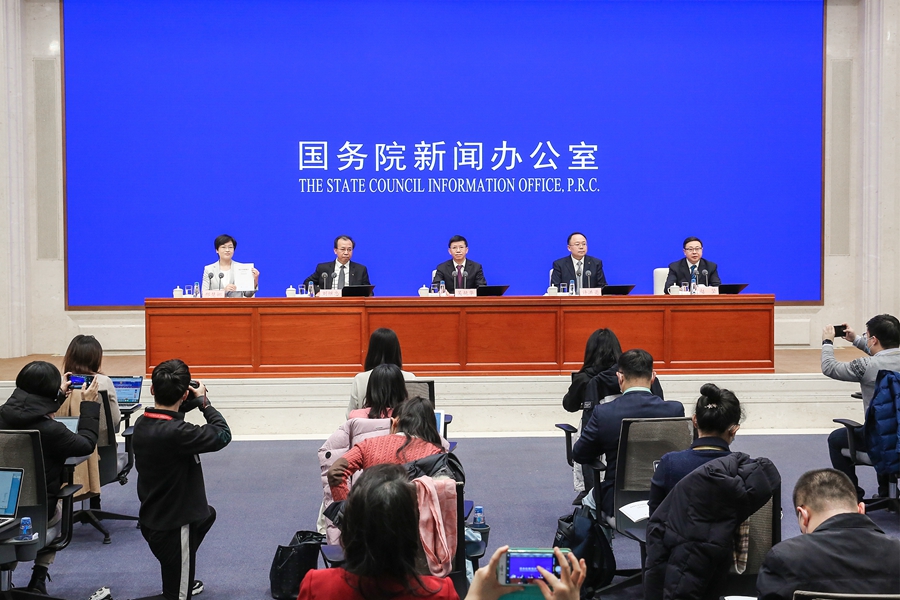



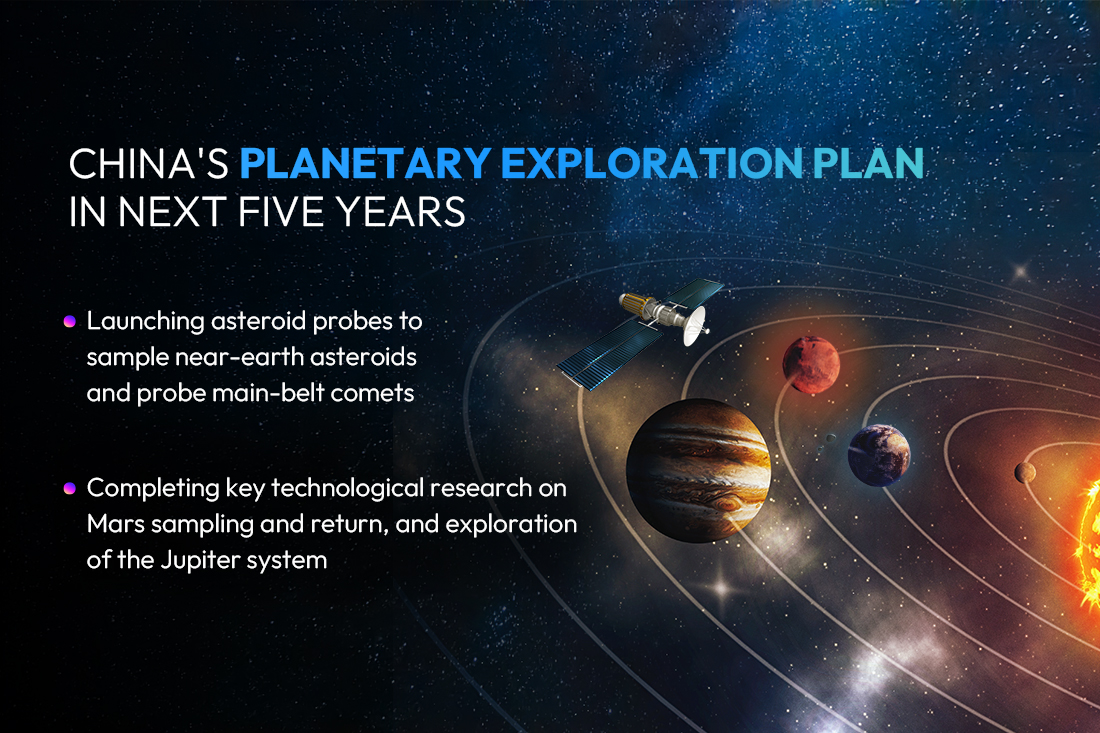
443379a0-f72e-4b7a-bd4e-c6d3aa3b8c52.jpeg)

